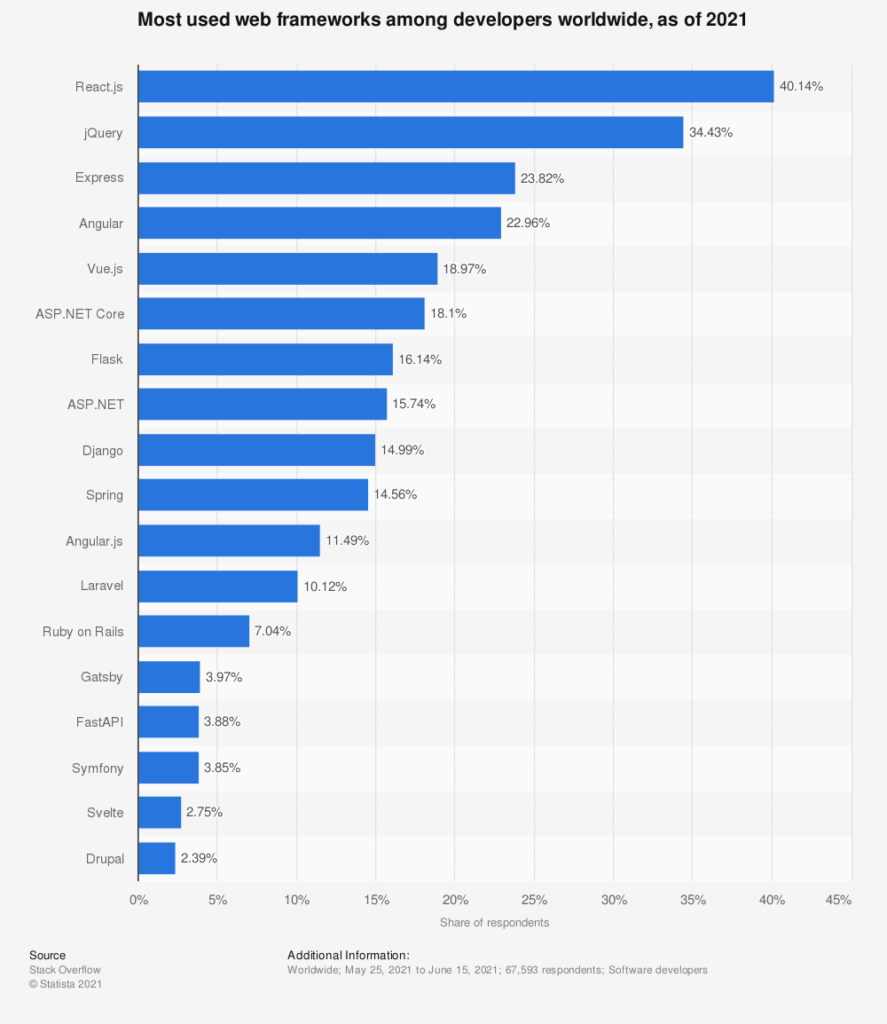Frameworks are a vital part of web development just as application standards rise. It leads directly to developing dynamic online platforms and the required complexity of technologies. Many backend developers all over the world are using web app frameworks as an integral aspect of the development process. But selecting the most relevant one might be difficult with so many options available.
That’s why we bring you a list of the 6 top backend frameworks for web development.

What are the best backend frameworks in 2022?
Backend development relates to server-side application logic that connects directly with the database. It handles all the things behind the scenes. Because of it, the chosen backend framework has a significant impact on the performance of a web application and could determine the project’s success. In other words, it’s crucial to choose the right tech stack for a digital product.

Ruby on Rails
Rails is an open-source web application development framework based on the Ruby programming language. It encourages developers to model-view-controller (MVC) framework that comes with default web service, web pages, and database. At the same time, it allows users to freely build, analyze, and expand the software. To create dynamic apps, it mixes Ruby, HTML, CSS, and JavaScript.
Ruby on Rails is one of the most popular frameworks, owing to the fact it’s a free solution as well as the fact that it simplifies numerous repetitive programming aspects. It’s also often used for prototyping and developing MVPs (Minimum Viable Products). Many companies are using Rails, one of many examples could be Netflix or GitHub. At Applover, we used it to develop a marketplace vendor platform, a web app for the banking institution, or an eCommerce mobile app for restaurants.
The characteristic of this framework is prioritizing active record patterns, DRY (don’t repeat yourself), or CoC (convention over configuration). It’s also suitable for behavior-driven deployment or test-driven deployment. Both of these development methods are effective in lowering expenses.
Django
Django is another open-source web framework but based on Python. Built by developers, it was designed for rapid development and clean design. Django implements the model-view-template pattern that’s similar to MVC. It’s also developed with the idea of “batteries included” meaning that everything a developer would need is already built-in. Thanks to that, Django doesn’t require installing third-party libraries or plugins.
Among well-known sites that use Django is Pinterest or Mozilla Foundation. Because this framework is highly customizable and very scalable, it results efficiently in bigger projects. However, in the case of smaller projects, it may not be the best choice as the project is going to be bloated with unnecessary features.

Spring
Spring Boot is one of the most extensively used backend JavaScript frameworks. It’s a Java platform application framework that’s an inversion of the control container. It improves programming thanks to an emphasis on productivity, speed, and simplicity. Any project may use its fundamental features, but it also comes with several extensions for creating websites.
Spring Framework can be thought of as a collection of templates or a “template built from templates”. Most of these templates are designed to work independently, although using them together provides more functionality. Even though it doesn’t have any specific programming model, it’s one of the most popular open-source frameworks. Websites like Wix uses it. However, the learning curve may be rather severe.
Express.js
Express is a lightweight and adaptable Node.js web application framework that offers a comprehensive range of functionality for web online and mobile apps. Along with the AngularJS frontend framework and MongoDB databases, it’s a MEAN stack backend component. It’s also a typical server framework that is used for developing APIs and online applications.
Express is swiftly one of the most used frameworks for web development today. IBM, Uber, and many other firms use it, it’s also compatible with frameworks like Loopback or Kraken. But the fact that there’s no established manner of developing, might be Express’s big disadvantage.

Flask
Flask is a microweb Python-based framework that doesn’t require other tools or libraries. This backend framework for web development supports secure cookies, RESTful request dispatching, and Jinja2 templating. However, it lacks form validation and components that rely on third-party services. It supports extensions in a way that makes them appear to be built into the framework.
In opposition to Django, Flask is light weighted and hence appropriate for creating smaller projects. LinkedIn is one of the famous apps using it as a backend framework. For most users, it’s meant to give a great performance. This is due to the fact that there are fewer levels of abstraction and it has the ability to perform at a high level.
Laravel
Laravel is a PHP-based framework that is known for elegant, expressive syntax, flexibility to support huge teams, and current toolkit capabilities. Laravel was designed to allow for substantial backend development and also follows the already mentioned MVC pattern. It includes a comprehensive ecosystem and its own database migration.
The major goal of Laravel for websites is to make website upgrades enjoyable and straightforward. Because of its adaptability, features, and execution, it is generally chosen by developers. Some companies that are using Laravel are 9GAG or Razorpay. The source code for Laravel is posted on GitHub and is licensed under the MIT license. On the other hand, Laravel doesn’t compare to Django or Express when it comes to performance, which might be a disadvantage for large projects.
Contact
Do you want to find out more about back-end development?
Talk to us!How to choose the right backend framework?
There are many powerful back-end frameworks for web app development out there, each with its own set of pros and cons. But at the end of the day, your decision of API tech stack is project-specific. It all depends on the product vision, company objectives, and user demands. However, to choose the right one, it’s best to consult with top tech experts to hyper-grow your business and carefully examine your possibilities.





